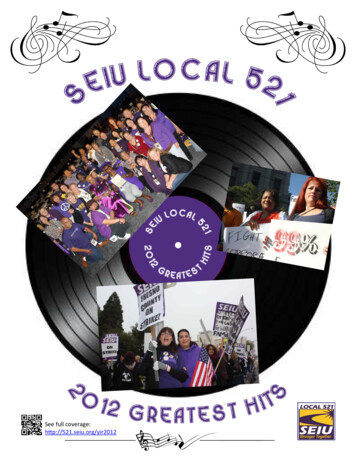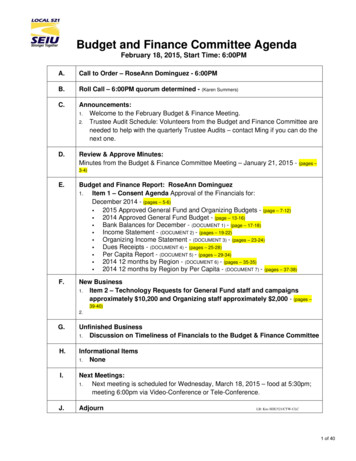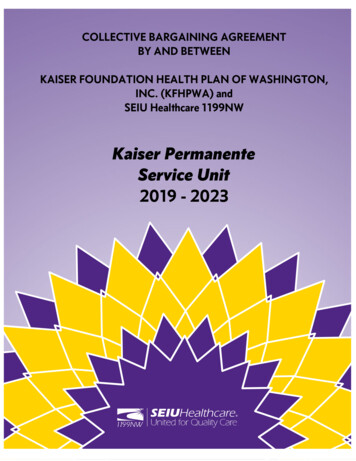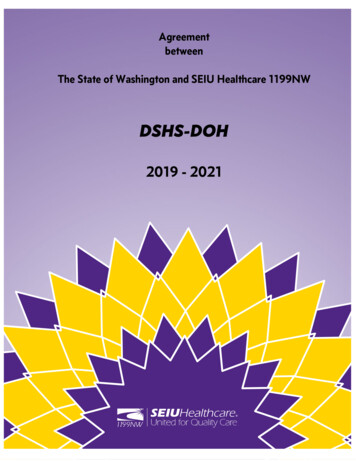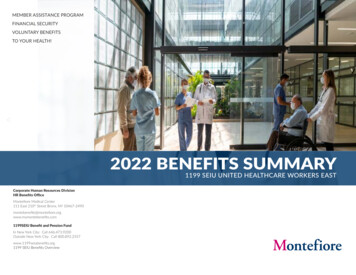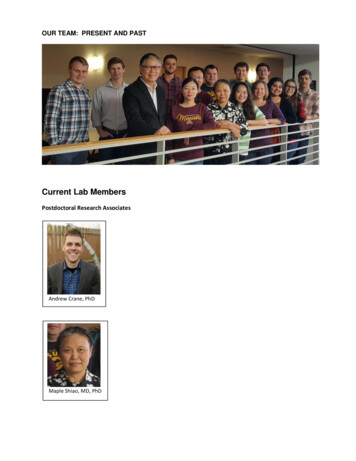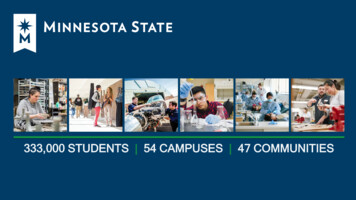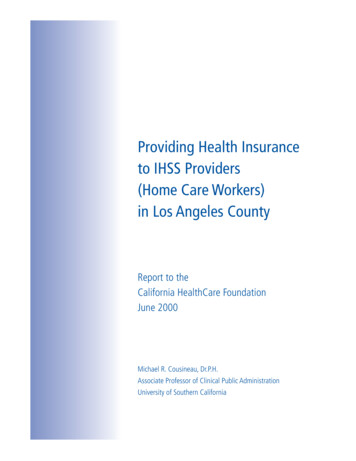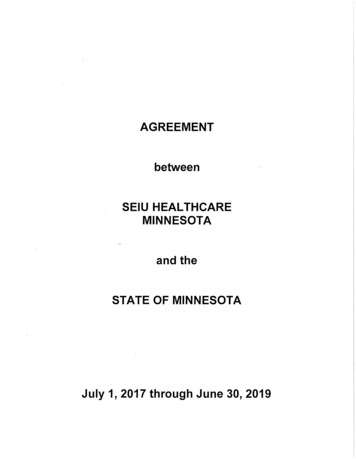
Transcription
AGREEMENTbetweenSEIU HEALTHCAREMINNESOTAand theSTATE OF MINNESOTAJuly 1, 2017 through June 30, 2019
TABLE OF CONTENTSPREAMBLE .1DEFINITION OF TERMS .1ARTICLE 1 - UNION RECOGNITION .2ARTICLE 2 - NON-DISCRIMINATION .2Section 1 - Prohibition Against Discrimination .2Section 2- Union Activity .3Section 3 - Program Participants Rights . 3ARTICLE 3 - PROGRAM PARTICIPANT RIGHTS .3ARTICLE 4 - COMPENSATION . .4ARTICLE 5 - PAID TIME OFF .4ARTICLE 6 - PAY FOR WORK ON A HOLIDAY . .4ARTICLE 7 - CAREER DEVELOPMENT FOR INDIVIDUAL PROVIDERS . 5ARTICLE 8 - GRIEVANCE AND DISPUTE RESOLUTION . 5Section 1 - lntent. .5Section 2 - Definition .5Section 3 - Grievance/Dispute Resolution Procedure . 5Section 4 - Expedited Arbitration .7Section 5 - Time Limits .7ARTICLE 9 - BACKGROUND CHECKS .7ARTICLE 10 Section 1 Section 2 Section 3 Section 4 -TRAINING .7Purpose .7The Committee .7Orientation .8Financing .8ARTICLE 11 - REGISTRY .8ARTICLE 12-STATE-PROVIDER COOPERATION COMMITTEE . 8ARTICLE 13 -ACCESS TO VACCINATION INFORMATION . 9Table of Contents - 1
ARTICLE 14- UNION RIGHTS . 9Section 1 - Dues Check-Off .9Section 2 - Individual Provider List . 10Section 3 - Bulletin Boards and Intermediary Offices . 10Section 4 - Orientation Materials . 10Section 5 - Website. 11Section 6 - Union Representatives . 11Section 7 - Copies of Notices to Fiscal lntermediaries . 11Section 8 - Indemnity . 11ARTICLE 15 - MANAGEMENT RIGHTS . 11ARTICLE 16 - FISCAL INTERMEDIARY RESPONSIBILITIES . 12ARTICLE 17 - DURATION . 13. ARTICLE 18 - SEVERABILITY . . 16ARTICLE 19 - COMPLETE AGREEMENT . 16ARTICLE 20 - APPROPRIATION . 16Table of Contents - 2
PREAMBLEThis Agreement is made and entered into this 21st day of June, 2017 by and between the Stateof Minnesota, hereinafter referred to as the "State," and SEIU Healthcare Minnesota, hereinafterreferred to as the "Union."This Agreement has as its purpose the promotion of harmonious relations, with mutual dignityand respect, between the parties; the establishment of an equitable and peaceful procedure forthe resolution of differences; the establishment of rates of pay and other conditions ofemployment; and to express the full and complete understanding of the parties relative to allterms and conditions of employment covered by the Agreement.The State and the Union share a commitment to strengthening and improving the home careprograms on which people with disabilities and seniors rely. The State and the Union agree thatrecipients of in-home care should be provided with the highest possible quality of services andsupports consistent with the principles of self-direction. We also agree that a stable, sufficientworkforce is essential in helping people with disabilities and seniors live, work, and participatein their communities.The parties recognize the importance of involving both Individual Providers and Participants instrategy decisions and policymaking, and that nothing in this Agreement is intended tosupersede or interfere with the principles of participant self-direction.The parties also recognize and respect the critical services provided by Individual Providers,their professionalism and dedication, and the importance of their contribution to the developmentof the best possible workforce and the delivery of high quality services to self-directed programparticipants in the State of Minnesota.The parties acknowledge that the State is the employer of Individual Providers for purposes ofcollective bargaining as defined under Minnesota Statutes Section 179A.54.If the parties mutually agree during the term of this Agreement, the Agreement may be modifiedby additional provisions relating to specific conditions covering the terms of employment statedherein. Any Agreement which is to be included as a part of this Agreement must so indicate,must be reduced to writing, and must be signed by the parties to this Agreement.DEFINITION OF TERMSThe following terms shall be interpreted as indicated below when used in this Agreement:(a) "Direct Support Services" means personal care assistance services covered by MedicalAssistance; assistance with activities of daily living (AD Ls) and instrumental activities of dailyliving (IADLs); and other similar, in-home long-term services and supports provided to anelderly person or a person with a disability by their employee or the employee of theirrepresentative to meet such person's daily living needs and ensure that such person mayadequately function in the person's home and have safe access to the community.1
(b) "Covered Program" means a program providing direct support services funded in whole orin part by the State of Minnesota, including the Community First Services and Supports(CFSS) program; Consumer Directed Community Supports (CDCS) services and extendedstate plan personal care assistance services available under programs established pursuantto home and community-based service waivers and under the alternative care program; thePersonal Care Assistance Choice (PCA Choice) program; the Consumer Support Grant(CSG) program; and any similar program that may provide similar services in the future.(c) "Individual Provider," also known as "Direct Support Worker," means an individual selectedby and working under the direction of a participant in a covered program, or a participant'srepresentative, to provide direct support services to the participant, but does not include anemployee of a provider agency, subject to the agency's direction and control commensuratewith agency employee status.(d) "Program Participant" or "Participant" means a person who receives direct support servicesthrough a covered program.(e) "Participant's Representative" means a Participant's legal guardian or an individual havingthe authority and responsibility to act on behalf of a Participant with respect to the provisionof direct support services through a covered program.(f) "Fiscal Intermediary" means the Fiscal Support Entity or Fiscal Management Service thatprovides support to participants and participant's representatives with regard to employingIndividual Providers. Prior to the implementation of a new fiscal management structure,PCA Choice Provider Agency shall be included in the definition of Fiscal Intermediary.ARTICLE 1. UNION RECOGNITIONThe State recognizes the Union as the exclusive representative under Minnesota PublicEmployee Labor Relations Act (PELRA) for all Individual Providers in the bargaining unit certifiedby the Bureau of Mediation Services in Case Number 15PCE0010. The Union shall have therights and duties as prescribed by Minnesota Statutes Section 179A.54 and other applicableprovisions of PELRA and as set forth in this Agreement.The State shall not, during the life of this Agreement, meet and negotiate within the meaning ofPELRA with any other employee organization or any individual employee with respect to theterms and conditions of employment of the employees covered by this Agreement.ARTICLE 2. NON-DISCRIMINATIONSection 1. Prohibition Against Discrimination. The provisions of this Agreement shall beapplied to all Individual Providers without discrimination as to sex, marital status, sexualorientation, race, color, religion, disability, national origin, veteran status, union membershipstatus, current or former public assistance recipient status, age, or political affiliation.2
Section 2. Union Activity. The State shall not discriminate against, interfere with, restrain orcoerce an Individual Provider from exercising her or his right to join or not join the Union, to servein an elected or appointed position with the Union, or to participate in any other official capacityon behalf of the Union. The State shall remain neutral on the question of whether IndividualProviders should join the Union under PELRA. The State shall also require that all FiscalIntermediaries with which it contracts shall remain neutral on the question of whether IndividualProviders shall join the Union. All questions addressed to the State or its Fiscal Intermediariesby Individual Providers concerning membership in or representation by the Union under PELRAshall be referred to the Union.Section 3. Program Participants Rights. This Article does not apply to the ProgramParticipants' sole and undisputed rights provided in the law, including the selection andtermination of employment of Individual Providers.ARTICLE 3. PROGRAM PARTICIPANT RIGHTSThis Agreement shall not diminish in any way the rights of Program Participants to:1) select a service model of their choice;2) select, hire, direct, train, supervise, and terminate the employment of their IndividualProviders;3) determine levels of service;4) determine the work schedule of Individual Providers in their employ;5) manage individual service budgets, within the limits established by the State's coveredprograms;6) determine Individual Provider wages in accordance with Article 4 of this Agreement; and,7) receive direct support services from Individual Providers not referred to them through a stateregistry.No actions taken by the Program Participant, or Participant's Representative, with respect to thisArticle or any other participant rights shall be subject to the grievance and arbitration proceduresprovided for in this Agreement.This Agreement shall not be interpreted to require the State to release confidential personalinformation regarding any Program Participant to the Union, without the express written consentof a Program Participant, or Participant's Representative.Personal information includes, but is not limited to, Program Participants' names, addresses,telephone numbers, and email addresses.The Union and State agree that standards of confidentiality of Participant data should be followedin accordance with applicable state and federal law. Union representatives shall maintainconfidentiality regarding Program Participants and shall not disclose personal information abouta Program Participant obtained from any source unless the Program Participant, or Participant'sRepresentative, has authorized the disclosure in writing or legal proceedings compel thedisclosure.3
ARTICLE 4. COMPENSATIONEffective July 1, 2017, the minimum hourly wage rate for all Individual Providers shall be 11.00.Effective August 1, 2017, the minimum hourly wage rate for all Individual Providers shall be 12.00.Program Participants or their representatives shall have the ability to choose to pay IndividualProviders wage rates above the levels established by this contract and in accordance with theparameters established under covered programs.ARTICLE 5. PAID TIME OFFPaid Time Off accruals shall be managed by each Fiscal Intermediary.Effective July 1, 2017, an Individual Provider shall accrue one (1) hour of Paid Time Off for everyfifty-two (52) hours worked in covered programs.Effective August 1, 2017, an Individual Provider shall accrue one (1) hour of Paid Time Off forevery forty-three (43) hours worked in covered programs.In order to utilize Paid Time Off, an Individual Provider must have worked at least six hundred(600) hours in covered programs.An Individual Provider must obtain the express consent of his or her participanUclient in order touse PTO.An Individual Provider may carry over up to eighty (80) hours of PTO from one State fiscal yearto the next.Up to eighty (80) hours of accrued PTO shall be cashed out upon termination of all employmentmanaged by a Fiscal Intermediary.ARTICLE 6. PAY FOR WORK ON A HOLIDAYAn Individual Provider shall be paid at 1.5 times his or her normal rate of pay for all hours workedon the Thanksgiving and Memorial Day holidays.In addition, an Individual Provider shall be paid at 1.5 times his or her normal rate of pay for allhours worked on the following holidays on these dates only: Labor Day, September 4, 2017 New Year's Day, January 1, 2018 Martin Luther King Day, January 15, 2018 Labor Day, September 3, 2018 New Year's Day, January 1, 2019 Martin Luther King Day, January 21, 20194
ARTICLE 7. CAREER DEVELOPMENT FOR INDIVIDUAL PROVIDERSThe State and the Union recognize the need for career development for Individual Providers toalign compensation with skills and experience. Initial strategies will focus on Individual Providerssupporting people with complex needs as defined below.Aligning compensation with skills and experience will enable people with complex needs toattract Individual Providers in a competitive marketplace.The State and the Union will develop recommendations for the OHS Commissioner or theCommissioner's designee for strategies for career development for Individual Providers,including additional financial incentives for Individual Providers to work for people with complexneeds. People with complex needs who may access increased financial incentives to attractIndividual Providers will be identified by the State through assessment as those people who areeligible for at least twelve (12) hours of persona-I care assistance services each day. IndividualProviders who may access increased financial incentives to work with people with complexneeds must complete designated training approved by the OHS Commissioner or theCommissioner's designee. Beginning July 1, 2018, increased financial incentives will include anincrease to the rate for personal care assistance services and budgets of people using COCSand CSG.ARTICLE 8. GRIEVANCE AND DISPUTE RESOLUTIONSection 1. Intent. The purpose of this procedure is to secure, in the easiest and most efficientmanner, resolution of grievances.The State and the Union commit to resolving conflict in a responsible manner, and to the use ofmediation and conflict resolution procedures when appropriate.The State and the Union agree that Individual Providers and Union representatives should makeevery effort to resolve concerns on an informal basis at the earliest opportunity. Accordingly, ifthe dispute involves the actions of a Fiscal Intermediary, the Individual Provider and/or the Unionshall address the issue through informal means with the Fiscal Intermediary prior to the initiationof the grievance process with OHS.Section 2. Definition. For the purposes of this Agreement, a grievance shall be defined as adispute or disagreement as to the interpretation or application of any term or terms of thisAgreement.Section 3. Grievance/Dispute Resolution Procedure. Step 1: Informal Resolutiono The Individual Provider and/or a Union representative may confer with the OHS designated representative and attempt to resolve the issue informally.o Where issues arise involving a Fiscal Intermediary, in recognition of the partnership withFiscal Intermediaries, the Individual Provider and/or a Union representative may contactthe Fiscal Intermediary and attempt to resolve the issue informally. A OHS-designated5
representative shall be included in or copied on all such communication between theIndividual Provider and/or Union representative and the Fiscal Intermediary. Step 2: Written Grievanceo If the Union wishes to initiate a formal grievance, the Union representative, with or withoutthe Individual Provider, shall, on a form supplied by the Union, set forth the grievance inwriting, including a statement of the pertinent facts surrounding the grievance, the dateon which the incident occurred, the alleged violations of the Agreement, and the specificremedy requested.o The written grievance shall be submitted to the OHS-designated representative withintwenty-one (21) calendar days of the occurrence of the alleged violation or within twenty one (21) calendar days of when the Individual Provider or the Union could reasonablyhave been aware of the incident or occurrence giving rise to the grievance. The writtengrievance shall be submitted by email.o The OHS designee shall contact the Union representative within seven (7) calendar daysof receipt of the written grievance, and schedule a meeting in order to discuss and resolvethe grievance. Subsequent to this meeting, OHS shall provide a written response to thegrievance to the Union by email within ten (10) calendar days from the date the partiesmet to discuss the grievance. If the response does not resolve the grievance, the Unionmay, within twenty-one (21) calendar days of the date the written response is given ordue, proceed to Step 4, Arbitration. Step 3 (Optional): Mediationo As an alternative prior to final and binding arbitration in Step 4, if the grievance is notresolved in Step 2 the parties may choose by mutual agreement to submit the matter tomediation through the Minnesota Bureau of Mediation Services ("BMS") to resolve it. Step 4: Arbitrationo If the grievance is not settled at Step 2 or Step 3, the Union may appeal the grievance inwriting to final and binding arbitration. The written appeal must be submitted to theAssistant State Negotiator of Minnesota Management and Budget or the MinnesotaManagement and Budget Commissioner's designee. Any grievance that is not appealedin writing by the Union to the Assistant State Negotiator or the Minnesota Managementand Budget Commissioner's designee within twenty-one (21) calendar days after OHS'swritten answer is submitted or due shall be waived.o The arbitration proceeding shall be conducted by an Arbitrator to be selected from a panelof seven (7) arbitrators obtained from BMS. The Arbitrator shall be selected from thepanel by the following method: the Union and the State shall each strike names from thelist, alternating choices of names to strike, until only one arbitrator remains. Theremaining arbitrator shall hear the grievance and decide the case. The party that strikesfirst shall be determined by coin toss.o The award of the Arbitrator shall be final and binding upon both parties.o The parties shall each pay one half (1/2) the costs or fees, if any, of the Arbitrator. Eachparty shall be responsible for its own costs, including the costs of representation,advocacy and the costs of that party's appointed representatives.o The Arbitrator shall be without power to amend, modify, nullify, ignore, add to, or subtractfrom the provisions of this Agreement. The Arbitrator shall consider and decide only thespecific issue submitted in writing by the State and the Union, and shall have no authorityto make a decision on any other issue not so submitted.6
oThe Arbitrator shall be without power to make decisions contrary to, or inconsistent with,or modifying or varying in any way the application of laws, rules or regulations having theforce and effect of law.Section 4. Expedited Arbitration. If both parties mutually agree in writing, the parties mayskip any of the steps of the grievance procedure and utilize an expedited arbitration procedurefor mutually identified grievances in the interest of achieving swift and economical resolution ofthose grievances. Selection of the arbitrator and distribution of arbitrator costs and fees amongthe parties shall follow the same procedure as outlined under the Step 4 Arbitration procedure.All decisions are final and binding on the parties, but shall not be considered as precedential inany other proceeding or matter. The hearing shall last no more than three (3) hours unlessmutually agreed to by the parties.Section 5. Time Limits. The State and the Union agree that the time limits provided in thisArticle are essential to the prompt and orderly resolution of any grievance, and that each willabide by the time limitations. Days will be counted by excluding the first day and including thelast day of timelines. When the last day falls on a Saturday, Sunday or holiday, the last day willbe the next day that is not a Saturday, Sunday or holiday.Any grievance not properly presented in writing and within the time limits specified, or anygrievance not moved to the next step within the specified time limits shall be considered to havebeen withdrawn. If the State fails to meet the time limits specified, the Union may move thegrievance to the next step. Time limits may be extended only by mutual agreement of the parties.ARTICLE 9. BACKGROUND CHECKSIndividual Providers shall not be required to pay for the cost of any required background checks,including fingerprinting.ARTICLE 10. TRAINING AND ORIENTATIONSection 1. Purpose. The State and the Union recognize the importance and value of IndividualProvider training, education, and preparation to perform support services Program Participantsrequire. To enhance the quality of home care services provided to Program Participants byIndividual Providers and to improve the safety of home care work for both Individual Providersand Program Participants, the State and the Union agree to continue and further develop thework of the Training and Orientation Committee. The goal of the Committee's work is to makeavailable voluntary training programs, required orientation programs for all Individual Providers,and stipends of 500 for up to 5,000 Individual Providers who have completed designated,voluntary trainings made available through or recommended by the Committee. The Committeemay consider development of training programs that pay experienced Individual Providers toprovide on-the-job training to new Individual Providers serving the same Program Participant.Section 2. The Committee. The Training and Orientation Committee shall consist of no morethan six (6) OHS-designated representatives and no more than six (6) Union representatives.The Training and Orientation Committee shall determine training and orientation needs andpriorities, evaluate options for training and orientation subject matter, the frequency and7
locations of trainings and orientations, and potential partnerships with other organizations and/oracademic institutions for the provision of trainings, and make recommendations to theCommissioner of OHS or designee.Section 3. Orientation. All newly hired Individual Providers are required to complete anorientation to the State's home care programs. Orientation content shall include, at a minimum:principles of independent living and self-direction; prevention of fraud and abuse; basicoperational procedures (e.g., filling in time-sheets); HIPAA compliance and confidentiality forprogram participants; and a list of public health clinics in each county that offer vaccines.Section 4. Financing. The State agrees to provide 250,000 per year to the Training andOrientation Committee for providing trainings and orientation to Individual Providers. In addition,the State agrees to provide one-time funding of 56,000 effective July 1, 2017 to the Trainingand Orientation Committee for trainings and orientation.The State also agrees to provide one-time funding of 2.5 million effective July 1, 2018 forstipends of 500 for up to 5,000 Individual Providers who complete designated, voluntarytrainings made available through or recommended by the Training and Orientation Committee.The Training and Orientation Committee shall recommend a budget and OHS shall ensure allexpenditures are made in accordance with OHS policies and state law.ARTICLE 11. REGISTRYThe State and the Union agree that the creation of a Minnesota Home Care Registry - an on line(and telephone) matching service for program participants seeking workers and IndividualProviders seeking work to voluntarily use in order to find one another - would be a significantstep forward in improving the stability of the State's home care workforce. Participants whochoose to self-direct need reliable access to workers for both permanently scheduled hours andrespite services, and home care workers need reliable access to their desired number of workhours.The goal of the registry is to improve Participants' ability to find Individual Providers with desiredqualifications for needed services, and to enable Individual Providers to find work. It would alsoimprove Individual Providers' ability to take time off with the assurance that the Participant willcontinue to receive quality services.The State-Provider Cooperation Committee shall continue to make recommendations to theCommissioner of OHS or designee for the implementation, further development of, andimprovements to, the matching registry for Program Participants and Individual Providers. TheState, upon request of the Union, shall meet and confer regarding any concerns the Union mayhave related to the implementation or operation of the registry.ARTICLE 12. STATE-PROVIDER COOPERATION COMMITTEEThe State and the Union support a cooperative relationship between the parties, characterized· by trust, respect, and a shared commitment to improving the quality of the home care services8
program participants receive. In order to foster such a cooperative relationship, the parties agreeto continue and further develop the work of the joint State-Provider Cooperation Committee todeal with mutually identified issues through a problem-solving approach, and make relatedrecommendations to the Commissioner of OHS or designee.The Committee shall be composed of a mutually agreed upon number of representatives fromthe State and the Union. The Committee shall meet at least once per month, unless mutuallyagreed otherwise. The parties understand that the Committee is not intended to replace orsubstitute for the work of other councils, task forces, or other entities established by OHS toissue recommendations on home and community based services policy. Committee meetingsshall not be considered or used as a bargaining forum, or to make any specific amendments tothe Agreement, nor shall they be considered or used as a substitute for the grievance procedure.The Committee shall identify and address issues of mutual concern specific to IndividualProviders working in covered programs. The Committee shall be authorized to deliver to OHSand the Union recommendations regarding mutual areas of concern, including but not limited to:implementation of the Community First Services and Supports (CFSS) program; continueddevelopment and improvement of the matching registry for program participants and IndividualProviders; the initial strategies for career development described in Article 7; and any othermutually agreed upon areas of discussion.The Committee is authorized to establish subcommittees on specific issues.Thesesubcommittees may include representatives of the State or of the Union who do not serve onthe full Committee. The Committee shall be responsible for coordinating the activities of thesubcommittees.ARTICLE 13. ACCESS TO VACCINATION INFORMATIONThe State will make information about access to vaccinations through public health clinicsavailable to all Individual Providers through online orientation materials; sharing the informationwith Fiscal Intermediaries and asking them to share it with affiliated Individual Providers; andposting the information on the OHS web site.ARTICLE 14. UNION RIGHTSSection 1. Dues Check-Off. The Depa
SEIU HEALTHCARE MINNESOTA and the STATE OF MINNESOTA July 1, 2017 through June 30, 2019 . The State and the Union share a commitment to strengthening and improving the home care programs on which people with disabilities and seniors rely. The State and the Union agree that . state plan personal care assistance services available under .
